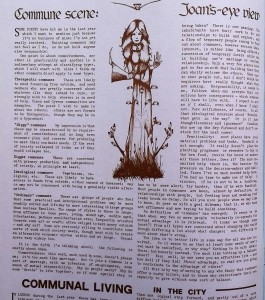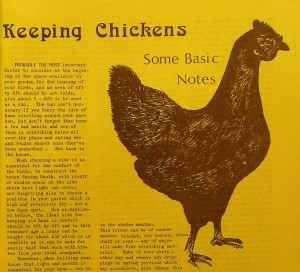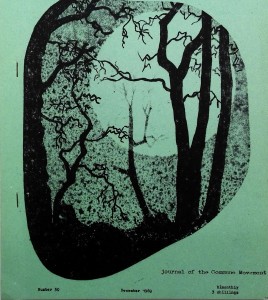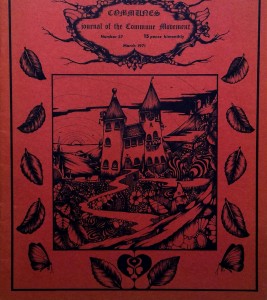This post is part of an ongoing series featuring items recently cataloged from the Julio Mario Santo Domingo Collection.
What exactly is a Commune? I’ll use the words from the Commune : Journal of the Commune Movement to explore the concept. According to Joan (one of the contributors) there are
 many different types of Commune scenes. You have therapeutic communes who are concerned with curing an ill of their choosing, specifically formed for this one purpose. We have “hippy” communes which are characterized by lack of commitment to everything, no economic plan or concern for meeting basic needs. Digger communes are focused on independence from society and making an alternate society of their own. Ideological communes are focused on a specific ideology such as vegetarianism or religion. Then we have the ordinary communes where people think that life is more interesting in large groups and that practical and interpersonal problems may be more easily solved within these groups. There is a mixture of people with different ages, beliefs, financial status, sexual orientations, and they are often oriented towards making a craft that can be sold outside the commune. Other characteristics are a willingness to contribute to a need of society as a whole but they are typically more interested in creating an alternate economic system.
many different types of Commune scenes. You have therapeutic communes who are concerned with curing an ill of their choosing, specifically formed for this one purpose. We have “hippy” communes which are characterized by lack of commitment to everything, no economic plan or concern for meeting basic needs. Digger communes are focused on independence from society and making an alternate society of their own. Ideological communes are focused on a specific ideology such as vegetarianism or religion. Then we have the ordinary communes where people think that life is more interesting in large groups and that practical and interpersonal problems may be more easily solved within these groups. There is a mixture of people with different ages, beliefs, financial status, sexual orientations, and they are often oriented towards making a craft that can be sold outside the commune. Other characteristics are a willingness to contribute to a need of society as a whole but they are typically more interested in creating an alternate economic system.
 For example this helpful article which reveals some basic tips on keeping chickens. To keep six chickens you want to have a 6ft by 4ft space which will ideally fit the coop and be facing South with plenty of windows to get as much light as possible.
For example this helpful article which reveals some basic tips on keeping chickens. To keep six chickens you want to have a 6ft by 4ft space which will ideally fit the coop and be facing South with plenty of windows to get as much light as possible.
The object of the Commune movement is clearly stated in each issue: To create a federal society of communities wherein everyone shall be free to do whatever he wishes provided only that he doesn’t transgress the freedom of another.
We discovered three issues that span 1969-1974 and give an interesting look at the evolution of the publication itself. Issue no.30 (1969) which is the green cover below is stapled together and most likely produced with a typewriter. No.37 (1971) has come quite a bit further for it is mass produced, has a table of contents, and contains well-articulated articles such as the one on types of communes I mentioned earlier. By the time we reach 1974 with our other issue the greater sophistication is clear with the detailed cover art, illustrations combined with articles, book reviews, and financial details of the organization.
To learn more about Commune life you can find Communes : journal of the Commune Movement. Taunton (Somerset) : Commune Movement, 1965- in Widener’s collection.
Thanks to Alison Harris, Santo Domingo Project Manager for contributing this post.



